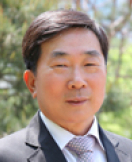
Professor Emeritus
whhong@kaist.ac.kr
- 1983 : Verfahrenstechnik Dr.-Ing., Technische Universität Berlin.
- 1979 : Verfahrenstechnik Dipl.-Ing., Technische Universität Berlin.
- 1973 : B.S. in Astronomy and Meteorology, Seoul National Univ.
- 1987 ~ Present : Professor, KAIST
- 1984 ~ 1987 : Senior Research Scientist, KIST
- 1980 ~ 1984 : Inst. f. Chem. Ing. Tech. TUB Wiss. Mitarb
- 2004.10 : Excellent Research Award, The Korean Society of Clean Technology
- 2008.10 : Excellent Research Award, The Korean Society of Clean Technology
- 2008.12 : Excellent Research Award, The Ministry of Knowledge Enonomy
- Bioseparation & μ-TAS
- Energy conversion & Electrochemical device
- Development of advanced Nanomaterials for Biosensor
- Separation Technology
- Cubic Mesoporous Graphitic Carbon Nitride: An All-in-One Chemosensor for Selective Optical Sensing of Metal Ions, Angew. Chem. Int. Ed. 2010.
- Solution Chemistry of Self-Assembled Graphene Nanohybrids for High Performance Flexible Biosensors, ACS Nano, 2010.
- Energy Transfer in Ionic-Liquid-Functionalized Inorganic Nanorods for Highly Efficient Photocatalytic Applications, Small, 2010
- Immobilization of genetically engineered fusion proteins on gold-decorated carbon nanotube hybrid films for the fabrication of biosensor platforms, Journal of Colloid and Interface Science, 2010.
- Mesoporous Melamine Resins by Soft Templating of Block-co-Polymer Mesophases, Chemistry of Materials, 2010.
- Selection of Optimal Operating Conditions for a Continuous CO2-Capture Process Using an Aqueous Ammonia Solution, Energy & Fuels, 2010.
Separation Process, Reactive Separation Technology, Mass Transport Phenomena in Fuel Cells, Carbon Nanomaterials
Bioseparation & μ-TAS
The separation technology such as reactive extraction, vacuum distillation and the crystallization is applied to produce the highly purified succinic acid from the fermentation broth produced by recombinant microbiology which is capable of the mass production of succinic acid.
Carbon nitride has been in the spotlight as alternatives to carbon materials due to its intrinsic functionalities, and superior electrical and optical properties. Owing to the attractive properties, carbon nitride is developed as novel nanostructured material for applications of photocatalysts, optical sensor, and absorbent for metal ions.
Micro-Total Analysis System (μ-TAS) such as μ-isoelectric focusing, μ-membrane separation and μ-chromatography is developed for the effective separation and concentration of proteins to analyze and screen proteins. This makes it possible to obtain enormous bio-informations with high speed and sensitivity.
The mass transfer and physical phenomenon in Fuel Cells are investigated by Computational Fluidic Dynamics (CFD) and electrochemical analysis. For the purpose of obtaining high performance of cell, proton conducting electrolytes are developed by fabricating emerging nanostructured hybrids as well as modifying the obtained materials. The theoretical and experimental findings are applied to the development of energy conversion & electrochemical devices.
Development of advanced Nanomaterials for BiosensorElectrochemical sensor has developed by using carbon nanomaterials such as carbon nanotubes and graphene. Recently, our group developed a simple, fast, and versatile method to assembly of nanoparticles on carbon nanomaterials, so-called ionic liquid-assisted sonochemical method (ILASM). As a key material in this method, ionic liquids play critical roles in controlling the size, packing density, and position of nanoparticles as well as in a functionalizer for a stable dispersion of carbon nanomaterials. As-prepared nanohybrids of nanoparticles and carbon nanomaterials were used as biosensing platforms for detecting various biomolecules, showing a high sensitivity, fast response time, and low detection limit.
Separation for Energy & EnvironmentSeparation technology is extended to the applicative field of energy and environment as a clean process. Absorption are used to capture CO2 as a global warming gas, adsorption to separate environmentally hazardous chemicals as one of projects for eco industrial park (EIP), and extraction to eliminate heavy metals.

